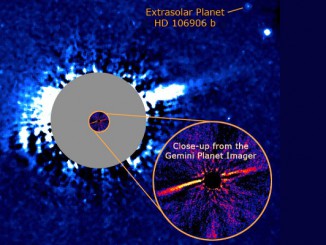
One of the best candidates for a potentially habitable exoplanet is likely an airless, irradiated wasteland that has been scorched by flares from its star, according to new research based on studies performed by NASA’s Kepler Space Telescope.
When its existence was announced in January 2015, Kepler-438b was heralded as one of the most Earth-like exoplanets discovered so far. This was despite the fact that the only things scientists knew about the planet for sure was that it was almost the same size as Earth (just 1.12 times bigger than our planet) and that it orbited in the so-called habitable zone of its star, which is the region around the star where temperatures are suitable for liquid water to survive on the surface of a planet.
However, Kepler-438b orbits a red dwarf star located 470 light years away in the constellation of Lyra and new work, reported in the 18 November issue of Monthly Notices of the Royal Astronomical Society by a team of scientists led by Dr David Armstrong of the University of Warwick, indicates that activity on the red dwarf may have rendered its planet inhospitable.
Despite their diminutive stature, red dwarfs are well-known to frequently experience powerful flares that release vast amounts of energy as magnetic field lines snap and reconnect. These flares often produce a coronal mass ejection (CME) – a giant cloud of plasma – that races away from the star and barrages any planets in its way.
The Sun also experiences flares that produce CMEs, but they are far less powerful than those observed on Kepler-438. The flares cause the star to brighten, which Kepler was able to detect whilst looking for dips in light that could indicate planets transiting across the face of the star.
“We saw seven flares in the four years of Kepler data and measured their energies – the strongest was 10^33 ergs,” Armstrong tells Astronomy Now. To put that into context, the most powerful flare on Kepler-438 was ten times more powerful than the strongest solar storm ever measured on Earth, which was the Carrington event of 1859.
Earth and its inhabitants are protected from solar storms by three things: the 149.6 million kilometres on average between Earth and the Sun puts us at a safer distance, the magnetic field that encases our planet can deflect CMEs and our atmosphere prevents particles, X-rays and most of the ultraviolet light emitted by flares from ever reaching the surface.
Kepler-438b may be lacking in all three of these advantages, says Armstrong. We know it orbits its star at a distance of 24.8 million kilometres, much closer than Earth orbits the Sun. Being so close, the planet is probably also in lockstep with its star, with its day lasting the same length of time as its year. In other words, the planet rotates on its axis in the same amount of time it takes to move around its star, meaning that it always shows the same face to its star. The dissipation of gravitational tidal energy as the planet fell into lockstep may have caused the planet’s molten core to stop spinning, or at least slow down, reducing the magnetic dynamo effect that creates the protective magnetic field. Because the particles in CMEs are electrically charged, a magnetic field can deflect them. Without a magnetic field, the CMEs are able to strip away the planet’s atmosphere, removing volatiles such as water molecules and leaving the surface vulnerable to radiation exposure. Even if the planet still has a magnetic field, it would likely be overloaded by the power of the flares.
“We don’t know anything about planetary magnetic fields outside of the Solar System, so it’s really an open question,” says Armstrong. “[But] even with Earth’s magnetic field, the planet would be badly affected.”
Strong flares are typical of red dwarfs, but in our search for potentially habitable exoplanets, Armstrong cautions against ruling out every terrestrial planet found around a red dwarf. Even so, perhaps they are not the most optimum locations to look for another Earth.
“While planets with the size and temperature of Earth are easier to find around red dwarfs, there’s no guarantee that they’re actually habitable,” he says.



